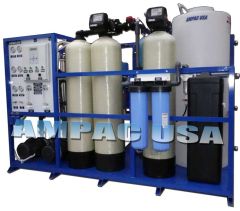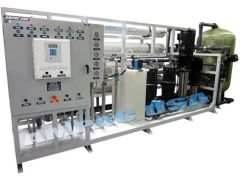Iron Removal
Iron and Manganese are the most common Ground water problem in the Water Treatment Industry today. Iron presence in water cause taste, staining, and many other problems. Iron and Manganese are chemically similar, they cause similar problems. Iron will cause reddish-brown staining of laundry, porcelain, dishes, utensils, and even glassware. Manganese causes brownish-black stains.
Detergents and Soap does not remove Iron and Manganese stains, and the use of chlorine bleach and alkaline builders can actually intensify the stains.
Iron and manganese deposits will build up in pipelines, water heaters, water softeners and pressure tanks. This reduces the flow and pressure of the water supply.
Iron and manganese accumulations raise other problems as water supply or water treatment and softening equipment must be replaced. There are also associated increased energy costs, like pumping water through constricted pipes or heating water with heating rods coated with iron or manganese minerals.
Iron and Manganese Bacteria
Some types of bacteria survive by reacting with soluble forms of iron and manganese. These organisms are usually found in waters that have high levels of iron and manganese. The reaction changes the iron and manganese from a soluble form into a less soluble form, thus causing precipitation and accumulation of black or reddish brown gelatinous material (slime). Iron, and/or manganese can clog plumbing fixtures and water treatment equipment, as well as staining laundry.
Maximum Acceptable Levels
The maximum contaminant levels (MCL) are set under the EPA Drinking Water Standards for iron is 0.3 milligrams per liter (mg/l) and for Manganese is 0.05 mg/l. Iron and manganese in excess of the suggested maximum contaminant levels (MCL) usually results in discolored water, laundry, and plumbing fixtures.
Water Treatment for Iron and Manganese Removal
Polyphosphate Treatment:
Polyphosphates Media react positively with dissolved iron and manganese by trapping them in a complex molecule that is soluble in water. As a result the iron and manganese are not available to react with oxygen and precipitate. Polyphosphates can be found is a form of a 10" and 20: filters or as a liquid that can be fed into the water system with controlled injection equipment.
Polyphosphate treatment is a relatively cheap way to treat water for low levels of iron and manganese. Depending on the type of polyphosphate used, water with 1 to 3 ppm of iron can be adequately treated.
Ion Exchange:
Soluble iron and manganese can be exchanged for sodium using an Ion Exchange Water Softener. This process of iron and manganese removal is the very same ion exchange process that removes hardness or calcium and magnesium (refer to the softening circular in the Treatment Systems for Household Water Supplies series). Iron and manganese are removed during normal operation of the water softener then removed from the medium along with calcium and magnesium during regeneration and backwashing. Some water softeners are capable of adequately treating water having iron up to 10 ppm. However, others are limited to treating water with iron no greater than 1 ppm.
Manganese Greensand Filter:
One of the best types of filtration to be used to remove Iron and Manganese in water is the Manganese green sand filter. The active material in "greensand" is glauconite. Glauconite is a green clay mineral. Glauconite often occurs mixed with other material as small pellets, thus the name "greensand."The glauconite is mined, washed, screened, and treated with various chemicals to produce a durable greenish-black product that has properties that allow it to adsorb soluble iron and manganese.
As water passes through the Green Sand Filter, Soluble Iron and Manganese are absorbed and later react to form insoluble iron and manganese. Insoluble iron and manganese will build up in the greensand filter and will be removed by backwashing. Backwashing is usually done regularly twice a week.
Backwashing (Regeneration) of the greensand is conducted using a permanganate solution. Regeneration will leave the greensand grains coated once again with a manganese material that adsorbs soluble iron and manganese. Frequency of regeneration will depend on the level of iron, manganese, and oxygen in the water.
Greensand filters are rated to treat water with iron concentrations of up to 10 ppm.
The pH will also influence the ability to remove iron and manganese. If the pH of the water is lower than 6.8, the greensand will probably not adequately filter out the iron and manganese. The pH can be raised above 7.0 by running the water through a ph Neutralizer or through calcite filter.
Chlorination (Oxidation) Plus Filtration:
Chemical oxidation followed by filtration is the best method of iron and manganese removal when concentrations are greater than 10 ppm. A chlorine solution is injected with a chemical feed pump or through a Tablet Chlorinator into an open tank, water have to settle for the chlorine to react.
Iron and manganese in water will be oxidized; soluble iron and manganese begin to precipitate almost immediately after contact with the chlorine solution converting them to ferric hydroxide and manganese dioxide. The flocculated material can then be removed by Sand filtration. The higher the amount of chlorine fed, the more rapid the reaction. Some plants have been designed for an initial chlorine residual of 5 to 10 ppm. After filtration the chlorine is removed by the addition of sodium bisulfide, sulfur dioxide, sodium bisulfide, or simply by Activated Carbon Absorption Methods.
An additional advantage of using the chlorination system is its bacteriacidal effect. Iron and manganese bacteria, along with other bacteria, are destroyed. Potential clogging problems in the sand filter are eliminated. Chlorination does produce trihalomethanes (THM) when organic matter is present in the water. (maximum contaminant level permissible in public water systems is 0.1 parts per million) and if necessary can be filtered out with an activated charcoal or carbon filter.
The optimum rate of oxidation of iron and manganese by chlorination is at a alkalinity level (pH) of 8.0-8.5, respectively. Soda ash injected with the chlorine will increase the pH to optimum levels. Adjusting the pH to alkaline levels also reduces the corrosive effect of the water to plumbing and fixtures.
Industrial Reverse Osmosis 8,000 GPD, AP8000-LX by AMPAC USA is ready to be shipped, highly automated and value for money.
View detailsBuy Quad Whole House BB UV, BB4-20 from AMPAC USA. We also offer commercial water filters. To buy Quad Whole House BB UV or any other device call 909-548-4900.
View detailsIon Exchange Twin Alternating Water Softener, AP3000S by AMPAC USA gets rid of the problem of hard water supply.
View detailsNo salt E Treat Water Softener, AP2500S by AMPAC USA allows you to get conditioned water that doesn’t lead to scale formation in pipes. Call 909-548-4900 to buy
View detailsIon Exchange Water Softener, AP2000S by AMPAC USA makes hard water drinkable in a jiffy.
View detailsIon Exchange Water Softener AP1500S from AMPAC USA, AP1500S is among the best water softeners as it eliminates many hardness minerals.
View detailsIon Exchange Water Softener AP1000S by AMPAC USA reduces the hardness levels in water quickly. To buy AP1000S Water Softener at best prices, call 909-548-4900.
View detailsIndustrial Reverse Osmosis 80,000 GPD, AP80K-LX by AMPAC USA serves industrial water needs of large industrial units. Call 909-548-4900 for early shipping at low cost.
View detailsIndustrial Reverse Osmosis 60,000 GPD, AP60K-LX by AMPAC USA is more affordable and highly cost effective. It can be customized too.
View detailsIndustrial Reverse Osmosis 6,000 GPD, AP6000-SM-LX by AMPAC USA eliminates impurities and TDS from the water.
View detailsIndustrial Reverse Osmosis 40,000 GPD, AP40K-LX by AMPAC USA serves giant water needs of communities, industries, and commercial units.
View detailsIndustrial Reverse Osmosis 30,000 GPD, AP30K-LX by AMPAC USA is awesome for large water needs of individuals and industries.
View detailsIndustrial Reverse Osmosis 25,000 GPD, AP25K-LX by AMPAC USA is ideal for residential, commercial and industrial use. Call 909-548-4900 to get it shipped fast.
View detailsIndustrial Reverse Osmosis 20,000 GPD, AP20K-LX by AMPAC USA is suitable to serve commercial units and residential communities.
View detailsIndustrial Reverse Osmosis 12,000 GPD, AP12K-LX by AMPAC USA is fully automated and works seamlessly with minimal human supervision.
View detailsIndustrial Reverse Osmosis 100,000 GPD, AP100K-LX by AMPAC USA meets the water needs of different industries perfectly. To buy it today, call 909-548-4900.
View details
















